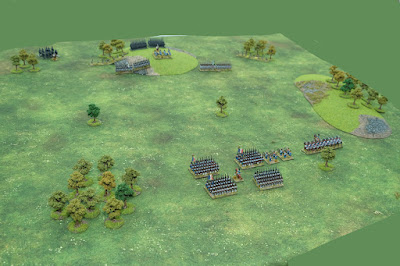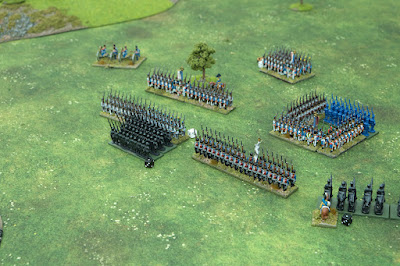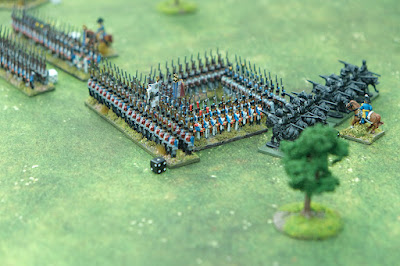Valour & Fortitude are a set of war-game rules authored by Jervis Johnson (of Black Powder fame) in collaboration with the Perry's, covering land actions from the Napoleonic Wars
With version 2 of these rules released tomorrow as a hard copy freebie with the October edition of Wargames Illustrated magazine and also currently available as a download from the Perry Miniatures web site, I thought I would give them a run and put them under a bit of pressure by having only 1 brigade per side, showing how suitable they are for an easy game at home.
Essentially the rules were initially conceived to help the Perry demo table at conventions, to get through a big game of 28’s in the limited time that a show permits. So designed with big tables, several brigades and multi-player games in mind, how will these fare on my smaller domestic table with a smaller scale and just one brigade per side.
Well, with some minor tinkering, I could get version 1 to cope, but the changes made to version 2 actually make this an easier thing to do.
Anyway, if any of this remotely interests you, please use the ‘read more’ tab for the rest of this post.
Above - at start. I am using the Epic figures from Warlord Games, which can be thought of as small 15mm.
The Prussians are at the top of the table in the photo, occupying the hill. They have 3 x line infantry, 1 x landwehr infantry, 1 x Uhlan lancer cavalry, 1 x field artillery and 2 x companies of jäger.
The French at the bottom of the picture have 4 x line infantry, 1 x field artillery and 1 x cuirassiers cavalry.
My units (infantry battalions / cavalry regiments and gun batteries) are each comprised of 2 bases (2 x 60mm), so with frontages at 120mm per unit, I am converting all game measurements (inches) into half inches. Centimetres would be more sensible, but I find Centimetres a little mean looking.
Above - the French positions as seen by the Prussian commander.
The table is 4' x 4' and in truth, bigger than we need for this. I am starting the forces set apart at just within max artillery range, 48" in the rules, but just 24" to us, using our half measurement.
Of significance is that the Brigade Commander can automatically command brigade units within 12" (6" to us) of his position. If the unit is further away than that, then it must take a test to see if messengers get through (need 4+), so there is an even chance of failure and if it fails, the unit cannot act in the Action Phase, so there is some good discipline here to encourage the brigade to keep together.
Of note, the Prussian Uhlans are light cavalry and when they take this messenger test, they get +2 to their die roll, so they have more latitude in doing a bit of roaming .... unlike the French cuirassier, heavy cavalry, who need to stay more tightly within brigade confines - which curtails them and is why, cavalry would be best put into a separate brigade with their own brigade commander.
Anyway today, we are combined arms within the same brigade and that's just how it is :-)
At the start of play, each side gets a FATE DECK, each comprising of 13 cards of one suit from a pack of playing cards. I am giving the French hearts and the Prussians spades.
Now follows an exploded view of turn 1 to demonstrate system and Sequence of Play and then after that, just the odd highlight is mentioned as they happen, to further highlight system.
I roll and the Prussians become player 1, this is normally determined in the scenario notes, but we are just doing a throw down exercise here, so it is a dice-off.
So we start with the FATE PHASE.
The Prussians draw the top card from their deck of 13 spades (I have a rather nice napoleonic themed pack of cards).
They get 7 of Spades. Each card has a listed 'ability'.
This one is described as "Directed Fire - Play this card when an enemy unit is chosen as a target in the fire phase. Add 1 to the fire value of the unit attacking that target. In addition, artillery units on a hill can trace a line of sight to the target across units that are not on a hill".
These cards can be saved in the hand for play later in the game and just used when needed, but the Prussians will want to use this in the current turn as they will be firing artillery at the approaching French.
FIRE PHASE - Infantry can fire at up to 12" (6" to us), so nothing is in range yet, but the artillery can fire and does. Artillery is quite low powered, getting 1D6 and needing 4+ to hit.
It selects an advancing infantry assault column. It must choose the nearest target that has not already been fired upon this turn. It takes 1D6.
To this it adds another D6 because the target is massed (assault column). They also play their 7 of Spades Fate Card and get another D6, so their opening fire in the game has 3D6.
They roll 6,6,2 getting 2 hits. The French column is marked with 2 hits.
Every unit has a Tenacity value and once it accumulates hits equal to that value, it is shaken and any further hits are instead taken as Valour Tests, if failed the unit routs instantly off the table! The French line infantry Tenacity value is 4.
ACTION PHASE - A players brigades attempt to activate. They need to each roll 2 - 6 to do so. A '1' is a fail and the brigade will not be able to take any actions this phase (ouch! You just know that will happen at the most critical moments).
The first brigade that tests, can automatically activate if the Army Commander is within 18", so this helps gives player focus to the most important part of the battle - but today, our Army Commander is off table, fighting on another part of the battlefield (imagining a bigger table or more brigades), with an eye on other brigades - perhaps to take that important bridge or village or to get a reserve into action.
Brigades act one at a time, each of their units can choose one (only) of these actions .... do nothing, move, retreat, assault, double move or rally.
The Prussians want to bring the lancers up on their right. They are more than 12" from the Brigade Commander, so must test for messengers. They only roll a '2'. This would normally be a fail, but being light cavalry, they get +2 to that test and pass.
Cavalry move 18" (9" to us). A unit that just moves normally (not double move or assault) can change formation at the start or end of movement - so after moving they decide to go into line.
The two Prussian infantry columns on the hill in reserve choose to move up, placing themselves either side of the gun battery.
MELEE PHASE - Melee is fought between all units presently in contact, but we are not there yet, so nothing happens.
That is the Prussian part of the turn concluded. The French player follows the same sequence.
The French introduce us to two new things. In the Action Phase, they attempt to rally off one hit from the French battalion that took artillery fire. They need 4+ (or 5+ if 12" or closer to an enemy), but fail!
They want to cover ground to get to the Prussians quickly, so they use Double Movement (not the unit that attempted rally, that has already been used). This allows them to cover twice the distance, but they must remain at least 18" (9" to us) from an enemy and cannot change formation.
The French infantry are happy to remain in their faster moving column formation, with a movement allowance of 12" (6" to us), so this restriction suits them.
Above - the situation at the end of turn 1. The French are closing but the brigade commander’s command span is getting stretched. The unit at the back with the small white dice did not move because it took a rally action.
Above - the Uhlans have compelled a leading French battalion to go into square.
Here are some things that happened during play that highlight some more system.
The Cuirassiers on the French right, want to charge Prussian infantry in front of them, but they are beyond command range, so test for messengers and only roll a '1', failing .... so can't move or take any other action this phase!
Charging a square is not impossible ... a 1 in 6 chance in fact. When cavalry contact a square, they must first make a contact test. On a D6, rolling a ‘6’ allows the charge to go ahead, but on 1 - 5, it will bounce off, perhaps with casualties.
Our Uhlans roll a '3' so of assaulting to contact, they instead retreat (think bounce off) and take one hit.
The cavalry would get a dice uplift when testing, increasing the chance of a successful charge if the square is shaken, encouraging some pre-charge fire to wear down the square, rather than relying on a reckless charge (Hello Mr. Ney).
The Landwehr battalion in assault column (the unit in raw black plastic in the below photo) uses an assault action to make contact with a French line infantry unit.
This is how melee works; It is in effect a simultaneous combat. Taking the Prussian assault column first, the Melee attack value of Landwehr is 4D6. They have no modifiers to hit and need 4+ on a dice to hit .... they score an impressive 4 hits.
Before taking those losses, the French 'fight back'. They too have a melee value of 4D6. They get an uplift of 1D6 for being in line (the effect of their fire). The infantry battalion to their rear is too far away to offer support, so the 5D6 are rolled. They only score 1 hit.
Since the Prussians inflict the most losses in the combat, they win the melee. The loser must take a Valour Test (the winner does not), but first the losses just made are added to the existing losses.
The French now have a horrible total of 6 hits, so they are Shaken (4 hits) and the 2 extra hits are converted over to Valour Tests - which are passed on a 4+. If any die roll fails, the tester will rout off the table!
So rather than just taking a single test for losing the melee, their high casualties result in them taking two tests … and both must pass.
They roll 5 and 5 and pass. The two units will stay in contact into the next players turn, but the French are now marked as shaken, with 4 hits.
A turn passes and the fight between these two units intensifies, an infantry battalion moves up to support the French. Ultimately it is of no consequence, the French unit loses another melee, take a Valour Test, fail and rout immediately off the table.
Example of Fortitude - When one or more units in a brigade rout, at the end of that phase, the Brigade commander takes a Fortitude test for each routed unit. A fail makes the brigade waver.
If it wavers, all remaining shaken units within the brigade immediately rout (removed). Then all units of the brigade within 6" (3" to us) of an enemy take 1 hit each.
Unfortunately for the French player, the brigade commander fails the Fortitude Test. The Prussian claim 1 'Defeat Point', which gets added to victory points at the end of play and then the French brigade resets itself automatically back from waver status to normal, but each time it wavers again, the chances of destruction get higher.
The Brigade does not have any shaken units at the moment, so nothing routs from the table, but two units are in proximity of the enemy, so each take 1 hit.
Above - a deciding moment.
The French square near the Uhlan cavalry have been taking musket fire from a Prussian infantry battalion over recent turns and have accumulated 4 hits and are now shaken.
The Prussians decide that this is the moment to attack the square. The infantry advance to contact (assault) and the Uhlan cavalry do the same. Only one unit in a combat attacks, the other(s) give a dice uplift for support.
First though the cavalry must test for making contact with a square, they fail and retreat. This will now be a melee just between the infantry units.
The French square loses the melee and the rules for square state that if a unit in a square loses a melee, it automatically routs (i.e. it does not get the chance to take a Valour Test).
The unit is simply removed from play and now, with that loss, the French brigade commander must take another Fortitude Test, which this time is passed, but with two units now routed and the Uhlans having gained the flank, the French side feel that the battle has been lost and they concede, retiring from the field.
Conclusion
I really like the updated rules. Awkward language has disappeared and the more streamlined way that damage / rally / valour and fortitude tests are now made, makes for a more streamlined process and overall, I think the rules are easier to hold in your head.
A consequence of all of this is that the system is naturally more flexible to fit various table and force sizes.
Above - Jäger's in a quiet part of the battlefield!
This small action took me a couple of hours, but I was re-familiarising myself with V2. There was enough of a game here and situations created, that the game was as good as any other system could do with six units per side.
Next up, I will go to a 6’ table and have two infantry brigades and a cavalry brigade, take on a single infantry brigade defending a village, just to see how those dynamics play out.
Anyway, this has been an excellent collaboration between the author, the Perry’s and Wargames Illustrated.
However you choose to get hold of the rules (hard copy from the WI magazine or digital download), there is a lot of goodness here for free and that only comes from the goodwill and hard work of all those key people involved who have a strong sense of wargame community - thank you to all who played a part in putting this into our hands.
Resource Section.
My sister webspace ‘COMMANDERS’ is being re-configured to showcase various figure and boardgame systems that I am enjoying and gives a flavour of where current projects are up to. Link.









